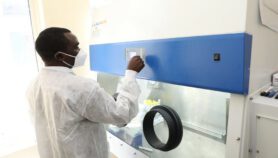Send to a friend
The details you provide on this page will not be used to send unsolicited email, and will not be sold to a 3rd party. See privacy policy.
Last week’s summit highlighted an opportunity for science centres to extend their sense of purpose.
The first generation of science centres prized industrialisation. Emerging around a century ago, these institutions encouraged members of the public to explore science by presenting the tools of the new age of iron and offering educational opportunities.
Since then science centres have evolved. Today’s generation of centres are keen to deliver value and reflect an activist awareness that responds to the needs of communities where they are based. This enduring concern with impact means the centres have become increasingly adept at exploring ways to innovate.
The result is ever more creativity, as the professionals behind these institutions come up with dynamic ways to use advances in technology to make science topical and exciting. [1]
There is certainly an audience for it: last year science centres and museums around the world received 310 million visitors.
There is another trend in the sector: a growing ambition to be policy-relevant.
New ambitions
This was demonstrated at the Science Centre World Summit held in Brussels, Belgium, last week (17–19 March), which drew 450 delegates: more than one third of them do not work in science centres. The plenaries on the first day mostly featured speakers from the media, public policy, and science research. This was a source of some pride for the organisers.
A number of the initiatives showcased at the summit described how some centres are themselves becoming spaces to serve policy for development. For instance, the project World Wide Views on Biodiversity involves science centres around the world that each convene 100 people from the general public to talk about how to improve people’s commitment to biodiversity. The European Network of Science Centres and Museums has also been engaging with the European Commission’s Responsible Research and Innovation concept, which aims to engage the public in setting research priorities.
“Science centres are rightly celebrated as beacons of our civilisation. Global development presents this community with a new, clear opportunity for growth.”
Nick Ishmael Perkins, SciDev.Net
But this new ambition faces an overwhelming challenge. Perhaps unsurprisingly, there is a dearth of centres in low-income countries — and this reflects, rather than challenges, inequality between countries.
If the network wants to be taken seriously by the likes of the UN, it has to offer a convincing contribution to the call for ‘no one to be left behind’, which looks set to underpin the next generation of development goals come 2015.
The challenges
There is interest in resource-poor countries. Across Sub-Saharan Africa, South Africa is one of just two countries with science centres — the other is Namibia. South Africa has a respectable 35 centres; and it is typical for middle-income countries like Brazil and Mexico to boost a fledging network of centres. But more significantly, the South African government is fielding queries from a dozen other countries across the continent keen to start their own initiatives.
Their appeal extends beyond Africa. Sri Lanka’s senior minister for scientific affairs, Tissa Vitarana, told the gathering that his country had harboured ambitions for a Science Centre for several years.
The problem is not one of demand. There is interest in a culture of science, consistent with economies shifting from being commodity-based to knowledge-based. The African continent already has over 3,000 hubs for technical innovation, reflecting a collective attempt to inspire more scientific awareness among producers and consumers.
While the hubs are important, most countries start to build a knowledge-based economy by investing in science, technology, engineering and mathematics (STEM) education. The constraints to delivering STEM education with sustained quality in resource-poor areas can be instructive for the science centre sector.
Two issues emerge repeatedly: achieving and maintaining high teaching standards when teachers emerge from the same education system they are expected to transform; and producing materials and implementing quality assurance where the diversity of local languages proves a real operational constraint.
Drawing investment
The stark reality is that science centres are expensive and require long-term planning, which makes them vulnerable to political gamesmanship and competing priorities. So champions need patience and resourcefulness — one delegate told me that it took nearly twenty years for Malta to secure funding for its planned centre.
The private sector could support the development of science centres. There are some intriguing examples, like ‘The Crystal’ in London, United Kingdom, the world’s largest exhibition on the future of cities, built by electronics multinational company Siemens.
But multinationals need incentives for such investment, and most poor countries will struggle to make the case that they will see a competitive return on their investment.
To demonstrate value in the policy arena of global development, science centres must apply their celebrated creativity to these challenges. This might mean tampering with traditional models in much same way that conventional banking had to reconfigure itself through mobile telephony to serve a new client group in Africa.
Policy for success
There are ideas worth exploring that draw on existing investment and comparative advantages.
Content developers at science centres in rich nations might find ways to involve citizens from low-income countries in exhibitions for their own local constituents, by linking them to transboundary issues such as the concept of planetary boundaries (quantitative limits to the Earth’s resources).
Centres can support STEM teachers through targeted activities, providing tools, inspiration and the prestige of partnerships. Speaking at the summit, Marie Levens, from the Organization of American States, made it clear that this is where she sees the greatest opportunity for collaboration with her office, the Department of Human Development, Education and Culture.
New science centres could link up with a growing number of research outfits and technology hubs in the developing world. A European example of how this can work is at CERN (the European Organization for Nuclear Research) in Switzerland, which has a successful science centre attached to it and has a year-long waiting list for visitors — a model that many at the summit suggested could be explored elsewhere.
Finally, the community has built a reputation for making an event of scientific learning for the general public. The same thinking should apply to policy audiences, providing them with a safe space to interpret scientific research and explore its social implications. Anne Glover, Chief Scientific Advisor to the European Commission, intimated as much in her address. Such programming will build demand and appreciation amongst a select but crucial group of stakeholders.
Science centres are rightly celebrated as beacons of our civilisation. Global development presents this community with a new, clear opportunity for growth.
Nick Ishmael Perkins
Director, SciDev.Net
@Nick_Ishmael
References
[1] Emlyn Koster, Evolution of Purpose in Science Museums and Science Centres, In: Fiona Cameron & Lynda Kelly (eds.) Hot Topics, Public Culture, Museums (Cambridge Scholars Publishing, 2010)














